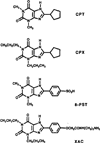Penetration of adenosine antagonists into mouse brain as determined by ex vivo binding
- PMID: 1540242
- PMCID: PMC3425645
- DOI: 10.1016/0006-2952(92)90257-j
Penetration of adenosine antagonists into mouse brain as determined by ex vivo binding
Abstract
The penetration of the adenosine antagonists 8-cyclopentyl-1,3-dimethylxanthine (CPT), 8-cyclopentyl-1,3-dipropylxanthine (CPX), 8-(p-sulfophenyltheophylline (8-PST), and 8-[4-[[[[(2-amino-ethyl)amino]carbonyl]methyl]oxy]phenyl]- 1,3-dipropylxanthine (XAC) into mouse brain was determined using ex vivo binding and locomotor studies. CPT and CPX (25 and 0.25 mg/kg, respectively) both penetrated into brain in substantial amounts: 49 and 17% of theoretical levels assuming free penetration throughout the body, 10 min after i.p. injection, respectively. Brain levels of CPT decreased rapidly, declining to undetectable levels by 30 min post-injection, whereas levels of CPX declined much more slowly. As expected, no detectable brain levels of 8-PST were found following i.p. injection of 50 mg/kg. XAC (20 mg/kg) penetrated into brain poorly: 1.6% after 10 min and 3.2% 20 min post-injection. The ability of CPT to stimulate locomotor activity paralleled the brain levels, i.e. it was similar to theophylline at short times and the effect rapidly diminished. These studies demonstrate the usefulness of ex vivo binding in determining CNS penetration of adenosine receptor ligands.
Figures





References
-
- Barraco RA. Behavioral actions of adenosine and related substances. In: Phillips JW, editor. Adenosine and Adenine Nucleotides as Regulators of Cellular Function. Boca Raton, FL: CRC Press; 1991. pp. 339–366.
-
- Daly JW, Bruns RF, Snyder SH. Adenosine receptors in the central nervous system: Relationship to the central actions of methylxanthines. Life Sci. 1981;28:2083–2097. - PubMed
-
- Daly JW, Padgett W, Shamim MT, Butts-Lamb P, Waters J. 1,3-Dialkyl-8-(p-sulfophenyl)xanthines: Potent water-soluble antagonists for A1 and A2 adenosine receptors. J Med Chem. 1985;28:487–492. - PubMed
Publication types
MeSH terms
Substances
Grants and funding
LinkOut - more resources
Full Text Sources
Other Literature Sources
Research Materials

